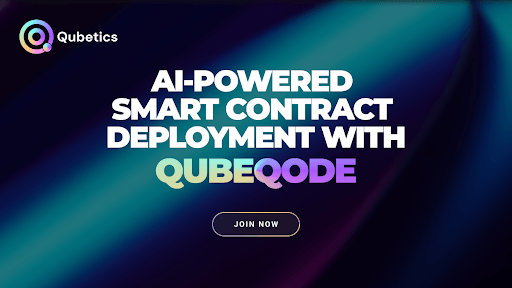In a world where traditional finance is moving too slow and asset yields barely keep up with inflation, crypto has become the fast lane for bold, forward-thinking capital. Not just because of the tech, but because it hands real people a shot at better returns, more access, and sometimes even a say in how the ecosystem evolves. For Latin American community members tired of jumping through hoops in the banking world, blockchain solutions offer something way more flexible—and frankly, way more fair.
Now, when talking about the top cryptos to hold for short term, a few names stand out not just because they’re trending, but because they actually bring something tangible to the table. That’s where Qubetics (TICS) starts turning heads. Backed by real-world use cases and a growing, hyped-up presale, it’s lighting up both technical charts and Telegram chats alike. Side-by-side with seasoned platforms like Polkadot and Render, Qubetics shows why it deserves the spotlight among serious blockchain contenders right now.
Qubetics (TICS): A Rising Star in Real-World Blockchain Utility
Qubetics isn’t just another token trying to ride the hype wave—it’s laying bricks for the future of decentralized infrastructure. Designed as a Layer-1 blockchain built specifically for real-world asset tokenization, digital identity, and decentralized services like VPN and multi-chain wallets, Qubetics is quickly becoming one of the top cryptos to hold for short term. Its native token, $TICS, powers this ecosystem. But it’s not just the roadmap that’s causing a stir—it’s the execution.
One standout feature is QubeQode IDE—a slick, user-friendly integrated development environment that lets businesses, independent professionals, and even non-coders spin up smart contracts and dApps without sweating the codebase. Think of a small design studio in Medellín or a legal firm in Guadalajara wanting to tokenize digital assets or contracts—they can jump on QubeQode and get it done, no middlemen, no dev costs. A freelance music producer in Buenos Aires could tokenize royalty rights, or a coffee co-op in Colombia might use it to track logistics and share profits on-chain. It’s drag-and-drop meets digital ownership, and it’s catching on fast.
Qubetics is also crushing it in compliance. From built-in KYC features to audit-readiness, it’s clear this project is setting itself up for long-term credibility. Its cross-chain wallet supports seamless crypto transactions across major blockchains, giving users more control without compromising security. Whether it’s secure cross-border payments for businesses or anonymous internet access for activists through the decentralized VPN—Qubetics brings real-world value, not vaporware.
Presale Milestones & $TICS Growth Story
The buzz around Qubetics isn’t just noise—it’s got receipts. Right now, the crypto presale is in Stage 29, and the project has already sold over 507 million tokens to a strong base of 24,600+ holders, raising more than $16 million. The current token price sits at $0.1573, and here’s the kicker—those who jumped in at Stage 1 bought in at just $0.01. That’s a mind-blowing 1473% ROI for early buyers. But here’s the real deal: it’s not too late to make a move.
Even entering now at $0.1573, the upside is crazy. Analysts are predicting $TICS could hit $1 after presale, which means a 535% ROI. If it reaches $5, that jumps to 3078%. More bullish calls place it at $6 (3713%), $10 (6256%), or even $15 (9434%) after the mainnet launch. These aren’t just moonshot fantasies—these projections are based on the platform’s real-world infrastructure, token demand, and growth traction.
This isn’t some lottery ticket—it’s an opportunity that still has room for smart buyers to enter before the big wave crashes in. For anyone looking at the top cryptos to hold for short term, $TICS deserves a serious spot on the radar.
Polkadot (DOT): Cross-Chain King with Deep Roots
Polkadot has long been seen as a heavyweight when it comes to multichain networks. Built by Ethereum co-founder Dr. Gavin Wood, it was engineered from the ground up to solve one of crypto’s biggest pain points: interoperability. In a space where most blockchains are isolated like islands, Polkadot serves as the bridge—connecting blockchains so they can share information, assets, and applications securely and at scale.
Community members, developers, and backers from regions like Latin America, Europe, and Southeast Asia have leaned into Polkadot’s flexibility. Its relay chain-parachain model gives niche projects the freedom to operate with their own rules while tapping into a larger security and data-sharing framework. That’s a game-changer for teams building in sectors like healthcare, education, and finance—especially where trust and transparency are in short supply.
Over the years, Polkadot has carved out its place as one of the top cryptos to hold for short term for anyone looking to diversify beyond Bitcoin and Ethereum. It’s seen by many in the crypto circles as a solid alternative to traditional investments. You’re not just buying a token—you’re buying into an ecosystem that’s constantly expanding.
The crypto community respects Polkadot not just for its tech, but for its governance model too. Through on-chain governance, backers and adopters can propose and vote on protocol changes. It’s the kind of decentralized structure that actually gives the community a real say—unlike legacy financial systems where people just get dictated to from above.
In regions with shaky financial infrastructure or high inflation, Polkadot has offered a kind of digital sovereignty. And that kind of adoption isn’t slowing down. Whether someone’s goal is staking DOT for short-term yields or building on Substrate, Polkadot remains a safe bet for practical utility and sustainable returns.
Render (RNDR): Powering the Digital Creator Economy
Render Network has quietly been becoming one of the top cryptos to hold for short term, especially for community members who understand the creator economy. This project isn’t just about tokenizing assets or building DeFi—it’s about decentralizing GPU power. It’s the engine under the hood for artists, animators, game developers, and anyone needing heavy 3D rendering without shelling out for top-tier hardware.
What makes Render so unique is how it taps into unused GPU power from contributors all over the world. A gamer in Bogotá with a killer rig can rent out unused GPU power to a creator in São Paulo working on a metaverse scene, and both benefit—one earns RNDR tokens, the other cuts rendering costs. This makes high-end rendering more accessible and democratic, with zero reliance on centralized cloud providers like AWS or Google Cloud.
It’s also gotten serious respect in both the crypto and tech world. Major content platforms and animation studios are exploring Render for everything from VR content to photorealistic game development. Its Layer 2 structure on Ethereum helps speed up transactions and cut costs, giving it both technical polish and practical performance.
While RNDR isn’t new, its relevance is more clear than ever in 2025. The AI wave, immersive experiences, and NFT-powered art markets all need one thing—graphics processing muscle. And Render’s got it on lock. Many in the blockchain space see RNDR as the go-to project for tapping into decentralized computing without breaking the bank.
For those looking at alternative ways to generate passive income or hold assets tied to real digital use cases, RNDR is often one of the top cryptos to hold for short term. It’s backed by serious tech, a growing ecosystem, and a clear lane in the booming digital media world. It doesn’t try to do everything—it just does what it does exceptionally well.
Final Thoughts
Crypto’s not about gambling anymore—it’s about calculated, informed plays. Whether it’s Polkadot’s robust multichain infrastructure, Render’s decentralized GPU marketplace, or Qubetics’ ambitious push into real-world applications, these projects aren’t just fly-by-night ideas. They’re serving different segments of blockchain demand with conviction, clarity, and community-driven development.
But if there’s one name that stands out in terms of current entry value, upside potential, and real traction—it’s Qubetics. The presale’s heating up, and with over $15.9 million raised, it’s clear the crypto crowd isn’t sleeping on this one. From its killer QubeQode IDE to cross-border payment use cases, $TICS is locking down a spot among the top cryptos to hold for short term.
Those waiting for the “perfect time” might miss the boat. The presale is still live, and the price hasn’t hit a peak. There’s still room to jump in and ride the ROI wave before the mainnet launch flips the script. Don’t just watch—participate.
For More Information:
Qubetics: https://qubetics.com
Presale: https://buy.qubetics.com/
Telegram: https://t.me/qubetics
Twitter: https://x.com/qubetics
FAQs
1. What makes Qubetics a top crypto to hold for short term?
Qubetics offers real-world use cases like decentralized VPN, cross-chain wallets, and asset tokenization. Its ongoing presale and high ROI potential make it ideal for short-term strategic holding.
2. How is Qubetics different from Polkadot and Render?
While Polkadot focuses on blockchain interoperability and Render powers decentralized GPU rendering, Qubetics blends DeFi, utility, and user-friendly development tools like QubeQode IDE—tailored for businesses and professionals.
3. Is it still worth joining the Qubetics presale in stage 29?
Yes, with $TICS priced at $0.1573 and ROI projections reaching up to 9434%, entering now still offers high upside potential before the token hits exchanges.
4. What are the main use cases for Qubetics in real life?
Qubetics can be used for secure cross-border payments, building dApps without code, running decentralized internet access, and tokenizing real-world assets—ideal for individuals, freelancers, and enterprises.
5. Why are Polkadot and Render considered reliable for short-term holding?
Polkadot is known for its powerful multichain architecture and governance model, while Render is widely respected in the creator economy for democratizing access to GPU rendering. Both have consistent demand and adoption.





